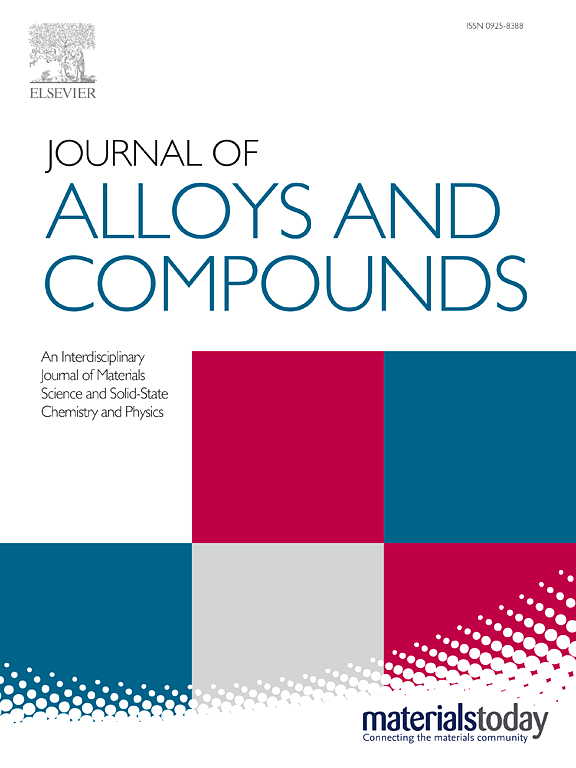Eu3+活化Na2Zn5Mo6O24:一种新型高量子效率和热稳定性的发光纳米荧光粉的光谱研究
IF 5.8
2区 材料科学
Q2 CHEMISTRY, PHYSICAL
引用次数: 0
摘要
本研究研究了一种新型的发光纳米荧光粉,Eu3+掺杂Na2Zn5Mo6O24,通过溶胶-凝胶法合成用于光电应用。Eu3+离子通过5D0→7F2超敏跃迁(~615 nm)发出红光,由于在紫外到蓝光光谱范围内的弱振荡吸收而面临固有的限制。为了解决这一问题,采用钼酸盐基质Na2Zn5Mo6O24在近紫外波长范围内实现了Eu3+离子的有效激发。结构分析证实了一个三斜相(空间群P-1),其相纯度跨越掺杂浓度(x = 0.01-0.06)。该纳米荧光粉在395 nm激发下表现出强烈的红光发射(CIE: 0.65, 0.34),量子效率(QE)为68.5%,热稳定性好(活化能ΔE = 0.279 eV)。在x = 0.05时,达到了辐射效率和浓度猝灭的平衡。集成纳米荧光粉的原型LED显示出高颜色纯度,暖白色LED的显色指数(CRI)达到90,验证了其在固态照明方面的潜力。本文章由计算机程序翻译,如有差异,请以英文原文为准。
Spectral studies of Eu3+-activated Na2Zn5Mo6O24: A novel red-emitting nanophosphor with high quantum efficiency and thermal stability
This study investigates the development of a novel red-emitting nanophosphor, Eu3+-doped Na2Zn5Mo6O24, synthesized via a sol-gel method for optoelectronic applications. Eu3+ ions, known for the red luminescence via 5D0 → 7F2 hypersensitive transition (∼615 nm), face intrinsic limitations due to weak oscillation absorption in the UV to blue spectral range. To solve this problem, the effective excitation of Eu3+ ions in the near-ultraviolet wavelength range was achieved by using the molybdate host Na2Zn5Mo6O24. Structural analysis confirmed a triclinic phase (space group P-1) with phase purity across doping concentrations (x = 0.01–0.06). The nanophosphor exhibited intense red emission (CIE: 0.65, 0.34) under 395 nm excitation, with a quantum efficiency (QE) of 68.5 % and superior thermal stability (activation energy ΔE = 0.279 eV). Optimal performance was observed at x = 0.05, balancing radiative efficiency and concentration quenching. Prototype LEDs integrating the nanophosphor demonstrated high color purity, and a warm-white LED achieved a color rendering index (CRI) of 90, validating its potential for solid-state lighting.
求助全文
通过发布文献求助,成功后即可免费获取论文全文。
去求助
来源期刊

Journal of Alloys and Compounds
工程技术-材料科学:综合
CiteScore
11.10
自引率
14.50%
发文量
5146
审稿时长
67 days
期刊介绍:
The Journal of Alloys and Compounds is intended to serve as an international medium for the publication of work on solid materials comprising compounds as well as alloys. Its great strength lies in the diversity of discipline which it encompasses, drawing together results from materials science, solid-state chemistry and physics.
 求助内容:
求助内容: 应助结果提醒方式:
应助结果提醒方式:


